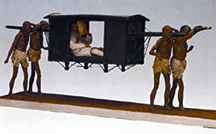Kahar
Kahar palanquin bearer. Although kahars are principally employed in palanquin bearing, they may also have other alternative occupations such as agriculture, fishing, and small business. Traditionally, a palanquin contains two edges in each of its sides. Two, four, six, eight, twelve or even sixteen kahars bear it in turn. At most two people can sit together in a palanquin. The number of kahars bearing a palanquin, however, depends more on the status of the passenger in it and the intended travel speed than the number of passengers and size of the palanquin. Kahars, like a gypsy group, travel to remote areas with bands, to carry bride and bridegroom or entourage of an important person. In the past, palanquin was one of the important means of transport.

Journey of a bride to bridegroom's house or vice-versa would require kahars. They were awarded richly for bearing the palanquins in which the bride or bridegroom rode. zamindars or rich landlords also used to travel in palanquins decorated with special motifs.
According to a doctrine of Hindu genealogists kahars are, by origin, a low caste of their community and represent a mixed caste descended from a brahman father and a chandal mother. Kahars themselves, however, claim that they are descendants from Jarasandha, king of Maghda. The religion of kahars is much the same as that of other Hindu castes of similar social standing. Most of them are worshippers of shiva or the Saktis, and the proportion of Vaishnavas among them is very small. Socially, the caste ranks with Kurmies and Goalas.
Kahars are also called beharas, a word coined in Bengali from the English word bearer. Local Hindu kahars bear the name mahara and Muslim kahars are called doli-walas, doliyas, or sawari-walas. Palanquin bearing being no longer the custom in the country, the doliyas has become cultivators, domestic servants, and day labourers. The development of a modern transport system and the introduction of engine vehicles forced the palanquin into a near extinct mode of transport and kahars are rarely seen anywhere in Bangladesh. [S M Mahfuzur Rahman]
